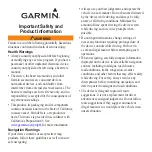
TM106601_(7/01) 2-
3
USE OR DISCLOSURE OF DATA CONTAINED ON THIS PAGE IS SUBJECT TO THE
RESTRICTION ON THE TITLE PAGE OF THIS DOCUMENT
.
C
O M M A N D
S
Y S T E M S
D
I V I S I O N
2.5 INSTALLATION OF SYSTEM COMPONENTS
2.5.1 Radar Antenna
2.5.1.1 Assembly of Antenna Array and Antenna Drive Assembly Procedure
(a) Remove the V-band coupling assembly (see Figure 2.9-6) from the antenna drive assembly.
(b) Butt the antenna array against the antenna drive assembly making certain that the array engages
the two guide pins located on the drive assembly. Secure the array/drive assembly together by re-
installing the V-band coupling assembly.
Antenna arrays are available with different
altitude specifications. Be sure that the array
altitude rating is greater than the desired
maximum aircraft operating altitude. Refer to
Table 1.2-1.
(c) Torque the two cap screws on the V-band coupling assembly 22 to 24-inch-pounds.
2.5.1.2 Installation of The Antenna and Antenna Drive (DA-1203A) Assembly Procedure
The radar antenna assembly is designed for mounting to the forward bulkhead, in the nose section of
the aircraft, behind a radome fabricated for the operating frequency of the radar system. The total
space required for the radar antenna can be determined from the dimensional information contained
on the radar antenna drawing, Figure 2.9-6.
Check that antenna is free to move in azimuth
(retaining pin removed) prior to applying power.
The antenna base hole pattern (see Figure 2.9-10) is compatible with the mounting holes provided by
the airframe manufacturers. The standard mounting provisions provided in the aircraft should
include a means for adjustment of the antenna, approximately
±
2.0 degrees in the pitch axis, by the
use of shims under the mounting pads.
Using an accurate spirit level prior to the actual mounting of the antenna can check alignment of the
mounting pads. Antenna alignment can be checked in service by means of the electrical tests outlined
in Paragraph 2.6.
CAUTION
CAUTION















































